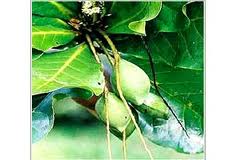| PlantID | 0125 |
| Botanical Name | Terminalia bellirica |
| Common Name | Bahera |
| Classification | | Kingdom: | Plantae | | Subkingdom: | Tracheobionta | | Division: | Magnoliophyta | | Class: | Magnoliopsida | | Subclass: | Rosidae | | Order: | Myrtales | | Family: | Combretaceae | | Genus: | Terminalia | | Species: | bellirica |
|
| Part used | Fruits |
| Medicinal Properties | Fruits: antidiarrhoeal, astringent, antipyretic, antileprotic. |
| Medicinal Use | Useful in leprosy, cough, bronchitis, allergic cough, insomnia, edema, dyspepsia, eye disease and graying of hair. It's pulp is used in dropsy, piles and diarrhoea. It is also used in oxalic acid and preparation of ink.
|
| Chemistry | Fruits: chebulagic acid, ellagic acid and it's ethyl ester, fructose, galactose, glucose and its galloyl derivative, mannitol and rhamnose and beta-sitosterol. Bark: chebulagic acid and ellagic acid. Seed-coat:gallic acid.
|
| Cultivation | NA |
| Regional Habitat | Throughout rajasthan, found in plains and lower hills, growing wild in deciduous forests. |
| Description | A large tree, grows up to 20-25 meters high, rust-coloured pubescence on young branchlets. Leaves: simple, alternate, long petioled and clustered at the ends of the branchlets, elliptic, entire and acute, 8-20 cm long. Spikes slender, interrupted, 8-15 cm long. Flowers: small, dirty-grey or greenish-yellow with a strong offensive smell, found in axillary spikes. Fruits: ovoid, grey, velvety, drupes contain single stony hard seed. Flowers in March-May and fruits in December-February.
|
| Image |  |


